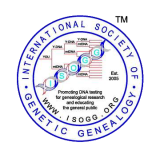Tutorial/ISOGG Wiki links
From ISOGG Wiki
< ISOGG Wiki:Tutorial| Quick Start Tutorial
|
|
| Introduction | Content guidelines | Registration | Editing | Formatting | Links | Citing sources | Talk pages | Wrap-up |
Contents
File:Boldness and links tutorial.ogv Linking ISOGG Wiki articles together is very important. These easily created links allow users to jump to information related to the article they are reading, greatly adding to ISOGG Wiki's usefulness.
How to link
To make a link to another ISOGG Wiki page (called a wiki link), put it in double square brackets, like this:
- [[Sandbox]]
which the reader will see, after you save your edit, as this: Sandbox
If you want to link to an article, but display some other text for the link, you can do so by adding the pipe "|" divider (SHIFT + BACKSLASH on English-layout and other keyboards) followed by the alternative name. For example:
- [[Genetic genealogy|genealogy using genetics]]
will display as this: genealogy using genetics
You can make a link to a specific section of a page like so:
- [[Genetic genealogy#Benefits|benefits of genetic genealogy]]
which will display as this: benefits of genetic genealogy
If you want the display text of the link to appear in italics or bold, nest the double square brackets for the link within the multiple apostrophes that delimit the italicized or bold text, like this:
- ''[[Mitochondrial Eve]]''
which will display as this: Mitochondrial Eve
Please check your links to ensure they point to the correct article. For example, Y-DNA haplogroup projects points to the article Y-DNA haplogroup project, while mtDNA haplogroup projects is the title of the article about haplogroup projects based on mtDNA. There are also "disambiguation" pages, which are not articles, but rather pages which contain links to articles with similar titles. Some, such as Haplogroup project are obvious, while others such as Haplogroup K use generic titles. These differing titles are where piped links are especially useful. For example, a wikilink of mtDNA haplogroup K project is much less readable than a piped link of haplogroup K, though both take the reader to the same place.
When to link
Adding links to an article makes it more useful, but too many links can be distracting. (Lead sections often have more links than other sections of articles.) To avoid excessive links, you should normally create a link in an article only where the first occurrence of a word or phrase occurs. And you should not link common words such as "state" and "world", even though ISOGG Wiki has articles for those words, unless these common words are central concepts to the article.
Looking at other ISOGG Wiki articles can help you learn when to add links.
Categories
You can also put the article in a category with others in a related topic. Near the bottom of the article, type [[Category:]], and put the name of the category between the colon and the brackets. For example, [[Category:ISOGG Wiki tutorial]].
It is very important to put in the correct categories so that other people can easily find your work. The best way to find which categories to put in is to look at pages on similar subjects, and check which categories they use. For example, if you write an article about a type of tree, you may look at an article on another type of tree to see which categories could be appropriate.
